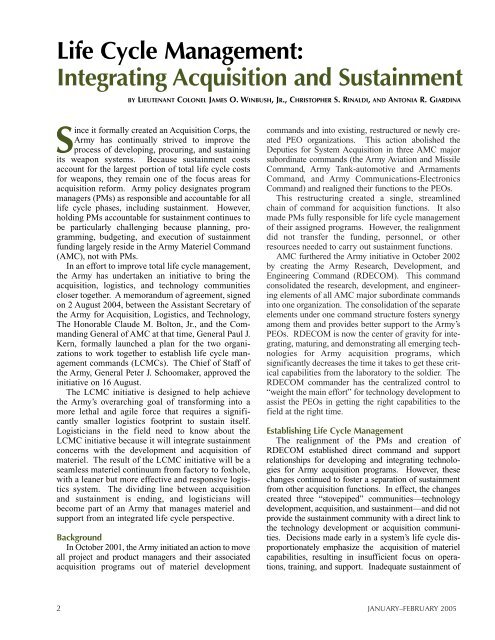Supporting the First Stryker Brigade in Iraq - Army Logistics ...
Supporting the First Stryker Brigade in Iraq - Army Logistics ...
Supporting the First Stryker Brigade in Iraq - Army Logistics ...
You also want an ePaper? Increase the reach of your titles
YUMPU automatically turns print PDFs into web optimized ePapers that Google loves.
Life Cycle Management:<br />
Integrat<strong>in</strong>g Acquisition and Susta<strong>in</strong>ment<br />
2<br />
BY LIEUTENANT COLONEL JAMES O. WINBUSH, JR., CHRISTOPHER S. RINALDI, AND ANTONIA R. GIARDINA<br />
S<strong>in</strong>ce it formally created an Acquisition Corps, <strong>the</strong><br />
<strong>Army</strong> has cont<strong>in</strong>ually strived to improve <strong>the</strong><br />
process of develop<strong>in</strong>g, procur<strong>in</strong>g, and susta<strong>in</strong><strong>in</strong>g<br />
its weapon systems. Because susta<strong>in</strong>ment costs<br />
account for <strong>the</strong> largest portion of total life cycle costs<br />
for weapons, <strong>the</strong>y rema<strong>in</strong> one of <strong>the</strong> focus areas for<br />
acquisition reform. <strong>Army</strong> policy designates program<br />
managers (PMs) as responsible and accountable for all<br />
life cycle phases, <strong>in</strong>clud<strong>in</strong>g susta<strong>in</strong>ment. However,<br />
hold<strong>in</strong>g PMs accountable for susta<strong>in</strong>ment cont<strong>in</strong>ues to<br />
be particularly challeng<strong>in</strong>g because plann<strong>in</strong>g, programm<strong>in</strong>g,<br />
budget<strong>in</strong>g, and execution of susta<strong>in</strong>ment<br />
fund<strong>in</strong>g largely reside <strong>in</strong> <strong>the</strong> <strong>Army</strong> Materiel Command<br />
(AMC), not with PMs.<br />
In an effort to improve total life cycle management,<br />
<strong>the</strong> <strong>Army</strong> has undertaken an <strong>in</strong>itiative to br<strong>in</strong>g <strong>the</strong><br />
acquisition, logistics, and technology communities<br />
closer toge<strong>the</strong>r. A memorandum of agreement, signed<br />
on 2 August 2004, between <strong>the</strong> Assistant Secretary of<br />
<strong>the</strong> <strong>Army</strong> for Acquisition, <strong>Logistics</strong>, and Technology,<br />
The Honorable Claude M. Bolton, Jr., and <strong>the</strong> Command<strong>in</strong>g<br />
General of AMC at that time, General Paul J.<br />
Kern, formally launched a plan for <strong>the</strong> two organizations<br />
to work toge<strong>the</strong>r to establish life cycle management<br />
commands (LCMCs). The Chief of Staff of<br />
<strong>the</strong> <strong>Army</strong>, General Peter J. Schoomaker, approved <strong>the</strong><br />
<strong>in</strong>itiative on 16 August.<br />
The LCMC <strong>in</strong>itiative is designed to help achieve<br />
<strong>the</strong> <strong>Army</strong>’s overarch<strong>in</strong>g goal of transform<strong>in</strong>g <strong>in</strong>to a<br />
more lethal and agile force that requires a significantly<br />
smaller logistics footpr<strong>in</strong>t to susta<strong>in</strong> itself.<br />
Logisticians <strong>in</strong> <strong>the</strong> field need to know about <strong>the</strong><br />
LCMC <strong>in</strong>itiative because it will <strong>in</strong>tegrate susta<strong>in</strong>ment<br />
concerns with <strong>the</strong> development and acquisition of<br />
materiel. The result of <strong>the</strong> LCMC <strong>in</strong>itiative will be a<br />
seamless materiel cont<strong>in</strong>uum from factory to foxhole,<br />
with a leaner but more effective and responsive logistics<br />
system. The divid<strong>in</strong>g l<strong>in</strong>e between acquisition<br />
and susta<strong>in</strong>ment is end<strong>in</strong>g, and logisticians will<br />
become part of an <strong>Army</strong> that manages materiel and<br />
support from an <strong>in</strong>tegrated life cycle perspective.<br />
Background<br />
In October 2001, <strong>the</strong> <strong>Army</strong> <strong>in</strong>itiated an action to move<br />
all project and product managers and <strong>the</strong>ir associated<br />
acquisition programs out of materiel development<br />
commands and <strong>in</strong>to exist<strong>in</strong>g, restructured or newly created<br />
PEO organizations. This action abolished <strong>the</strong><br />
Deputies for System Acquisition <strong>in</strong> three AMC major<br />
subord<strong>in</strong>ate commands (<strong>the</strong> <strong>Army</strong> Aviation and Missile<br />
Command, <strong>Army</strong> Tank-automotive and Armaments<br />
Command, and <strong>Army</strong> Communications-Electronics<br />
Command) and realigned <strong>the</strong>ir functions to <strong>the</strong> PEOs.<br />
This restructur<strong>in</strong>g created a s<strong>in</strong>gle, streaml<strong>in</strong>ed<br />
cha<strong>in</strong> of command for acquisition functions. It also<br />
made PMs fully responsible for life cycle management<br />
of <strong>the</strong>ir assigned programs. However, <strong>the</strong> realignment<br />
did not transfer <strong>the</strong> fund<strong>in</strong>g, personnel, or o<strong>the</strong>r<br />
resources needed to carry out susta<strong>in</strong>ment functions.<br />
AMC fur<strong>the</strong>red <strong>the</strong> <strong>Army</strong> <strong>in</strong>itiative <strong>in</strong> October 2002<br />
by creat<strong>in</strong>g <strong>the</strong> <strong>Army</strong> Research, Development, and<br />
Eng<strong>in</strong>eer<strong>in</strong>g Command (RDECOM). This command<br />
consolidated <strong>the</strong> research, development, and eng<strong>in</strong>eer<strong>in</strong>g<br />
elements of all AMC major subord<strong>in</strong>ate commands<br />
<strong>in</strong>to one organization. The consolidation of <strong>the</strong> separate<br />
elements under one command structure fosters synergy<br />
among <strong>the</strong>m and provides better support to <strong>the</strong> <strong>Army</strong>’s<br />
PEOs. RDECOM is now <strong>the</strong> center of gravity for <strong>in</strong>tegrat<strong>in</strong>g,<br />
matur<strong>in</strong>g, and demonstrat<strong>in</strong>g all emerg<strong>in</strong>g technologies<br />
for <strong>Army</strong> acquisition programs, which<br />
significantly decreases <strong>the</strong> time it takes to get <strong>the</strong>se critical<br />
capabilities from <strong>the</strong> laboratory to <strong>the</strong> soldier. The<br />
RDECOM commander has <strong>the</strong> centralized control to<br />
“weight <strong>the</strong> ma<strong>in</strong> effort” for technology development to<br />
assist <strong>the</strong> PEOs <strong>in</strong> gett<strong>in</strong>g <strong>the</strong> right capabilities to <strong>the</strong><br />
field at <strong>the</strong> right time.<br />
Establish<strong>in</strong>g Life Cycle Management<br />
The realignment of <strong>the</strong> PMs and creation of<br />
RDECOM established direct command and support<br />
relationships for develop<strong>in</strong>g and <strong>in</strong>tegrat<strong>in</strong>g technologies<br />
for <strong>Army</strong> acquisition programs. However, <strong>the</strong>se<br />
changes cont<strong>in</strong>ued to foster a separation of susta<strong>in</strong>ment<br />
from o<strong>the</strong>r acquisition functions. In effect, <strong>the</strong> changes<br />
created three “stovepiped” communities—technology<br />
development, acquisition, and susta<strong>in</strong>ment—and did not<br />
provide <strong>the</strong> susta<strong>in</strong>ment community with a direct l<strong>in</strong>k to<br />
<strong>the</strong> technology development or acquisition communities.<br />
Decisions made early <strong>in</strong> a system’s life cycle disproportionately<br />
emphasize <strong>the</strong> acquisition of materiel<br />
capabilities, result<strong>in</strong>g <strong>in</strong> <strong>in</strong>sufficient focus on operations,<br />
tra<strong>in</strong><strong>in</strong>g, and support. Inadequate susta<strong>in</strong>ment of<br />
JANUARY–FEBRUARY 2005







